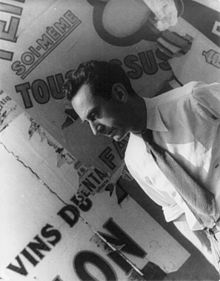Man Ray
| Man Ray | |
|---|---|

Man Ray, photographed at the Théâtre de la Gaîté-Montparnasse exhibition in Paris by Carl Van Vechten on June 16, 1934
|
|
| Born |
Emmanuel Radnitzky August 27, 1890 Philadelphia, Pennsylvania, United States |
| Died | November 18, 1976 (aged 86) Paris, France |
| Nationality | American |
| Known for | Painting, photography, assemblage, collage, film |
| Movement | Dada, surrealism |
Man Ray (born Emmanuel Radnitzky; August 27, 1890 – November 18, 1976) was an American visual artist who spent most of his career in France. He was a significant contributor to the Dada and Surrealist movements, although his ties to each were informal. He produced major works in a variety of media but considered himself a painter above all. He was best known for his photography, and he was a renowned fashion and portrait photographer. Man Ray is also noted for his work with photograms, which he called "rayographs" in reference to himself.
During his career as an artist, Man Ray allowed few details of his early life or family background to be known to the public. He even refused to acknowledge that he ever had a name other than Man Ray.
Man Ray was born as Emmanuel Radnitzky in South Philadelphia, Pennsylvania, U.S. in 1890. He was the eldest child of Russian Jewish immigrants. He had a brother and two sisters, the youngest born in 1897 shortly after they settled in the Williamsburg neighborhood of Brooklyn, New York. In early 1912, the Radnitzky family changed their surname to Ray. Man Ray's brother chose the surname in reaction to the ethnic discrimination and antisemitism prevalent at the time. Emmanuel, who was called "Manny" as a nickname, changed his first name to Man and gradually began to use Man Ray as his combined single name.
Man Ray's father worked in a garment factory and ran a small tailoring business out of the family home. He enlisted his children to assist him from an early age. Man Ray's mother enjoyed designing the family's clothes and inventing patchwork items from scraps of fabric. Man Ray wished to disassociate himself from his family background, but their tailoring left an enduring mark on his art. Mannequins, flat irons, sewing machines, needles, pins, threads, swatches of fabric, and other items related to tailoring appear in almost every medium of his work. Art historians have noted similarities between Ray's collage and painting techniques and styles used for tailoring.
...
Wikipedia
